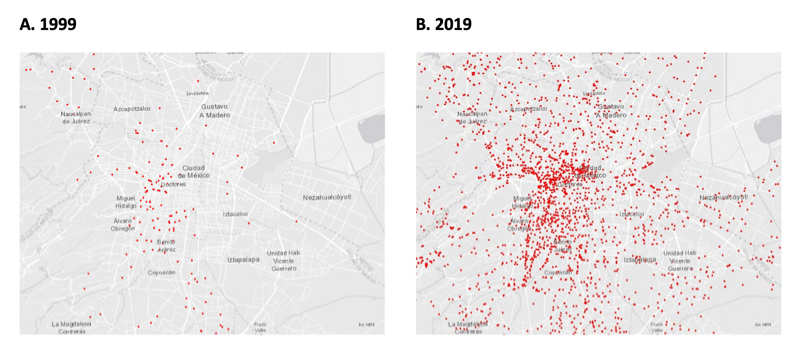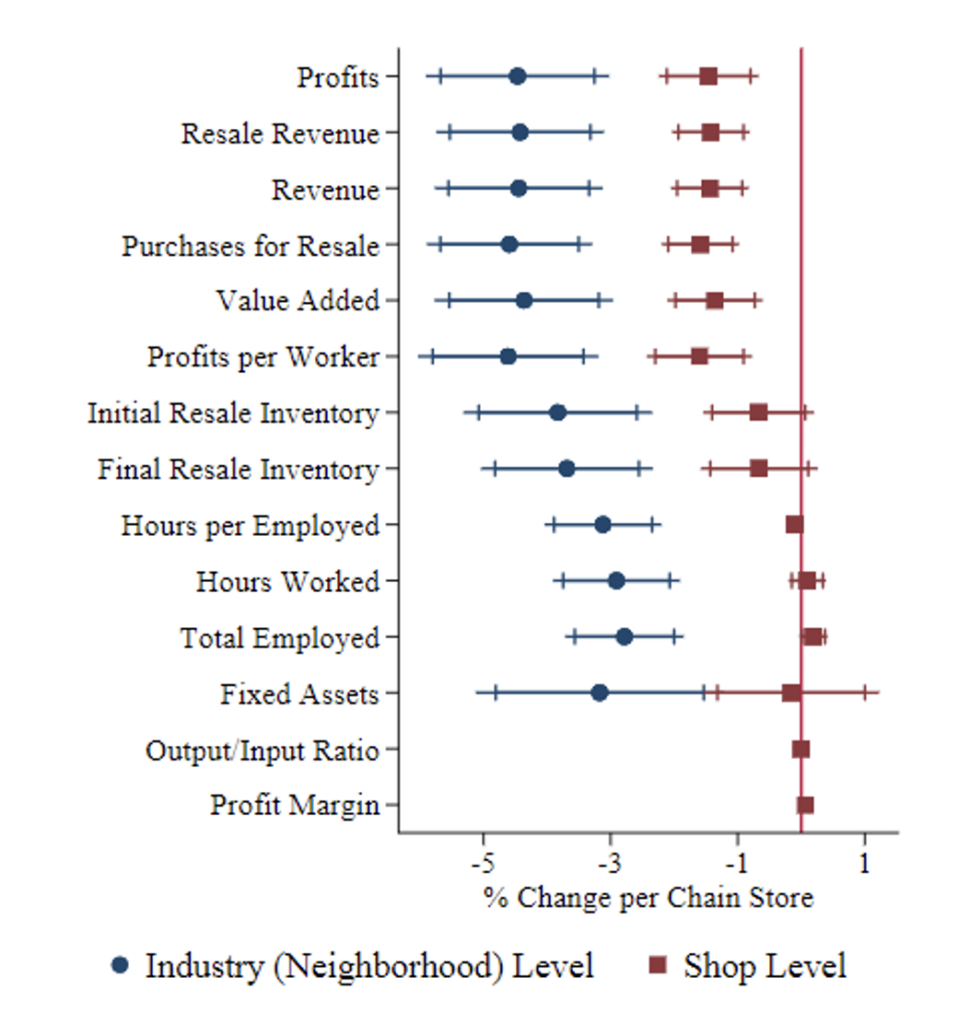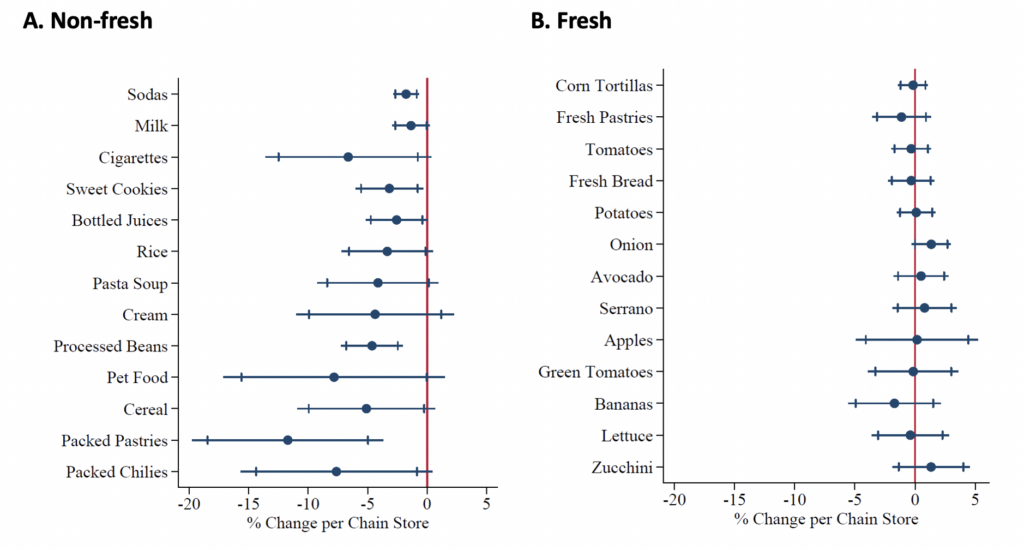
With its bountiful assortments of everything from tomatoes and milk to cigarettes and dog food, the little grocery store or “tiendita” is as ubiquitous and cherished as the bakeries, small liquor stores, and tacos stands that dot nearly every neighborhood in Mexico’s cities. But over the last 20 years, tienditas have faced significant competition from convenience chains like Oxxo and 7-Eleven, which boast more than 20,000 stores between them, and appeal to consumers because of features like similarly small store sizes, products and prices, and 24/7 operations.
Chains have numerous commercial advantages over tienditas. One is scale, including cost-sharing among stores, bargaining power with suppliers, and investments in productivity-enhancing technologies. They also reduce customer’s efforts to search out shopping opportunities, with their uniformity, location on wide streets and large advertisements. Still the tiendita continues to be a remarkably resilient neighborhood institution. Indeed, the 600,000 tienditas throughout Mexico, remain a formidable retail force, accounting for one in eight businesses, 4% of national employment, and the largest market share in the food and beverage industry (31%).
The Broader Ramifications for Microenterprises
The continued resilience and survival of the tiendita in the face of the ultra efficient chain is but one example of an intriguing phenomenon in developing countries. Hundreds of millions of microenterprises continue to thrive in the developing world despite more cutting-edge competitors, counfounding the predictions of most standard economic models in which the entry of more efficient firms into a market leads to a reallocation, as less efficient ones exit.
In a recent IDB publication, studies I sought to examine this phenomenon of the surviving microenterprise by focusing deeply on the Mexican tienditas. I assembled a rich collection of microdata for the study, including confidential performance measures, such as revenue and profits, for the universe of shops in Mexico between 1999 and 2019. These detailed firm data are linked with household income and expenditure surveys from 2006 to 2018, which include information on what households buy, where they buy it, and how much they pay for it.
Figure 1. Expansion of Chains in Mexico City 1999 – 2019

Figure 2. Effects on Shops’ Performance

The introduction of the chain stores has had an unquestionably competitive effect, I found. An additional convenience store in a neighborhood reduces the number of tienditas by four. This means that expanding from zero to the average number of chains in a neighborhood reduces the number of tienditas by 15%. This reduction is not driven by more tienditas exiting the market, but by a 21% decrease in tiendita openings. The adverse effects on tienditas concentrate on the extensive margin. At the neighborhood level, total profits, revenues, value-added, inventories, employees, and hours worked decrease by 20% to 30%. However, the magnitude of these adverse effects at the store level (intensive margin) is lower, ranging from 0% to 7%.
Customers still shop at tienditas, but less frequently. An expansion of convenience chains from zero to the average number in a neighborhood decreases the probability of neighbors shopping at tienditas by 4%. Those who continue shopping at tienditas do so 7% less often and buy 10% less. Chains do not affect household expenditure in tienditas for fresh products such as pastries, fruit, and vegetables, often sourced daily by shop owners from central markets. Still, they decrease household purchases in the traditional shops by 15% for packed and standardized products, like sodas, milk, and bottled juices.
The Tiendita’s Comparative Advantages
Evidence suggests that in the face of the fierce competition from the chain stores tienditas adjust and leverage their comparative advantages. Chains do not affect the productivity of tienditas. These traditional stores respond to falling sales by reducing their purchases and inventories. Moreover, the smaller and owner-operated tienditas are the least affected by the new form of competition. This is consistent with the idea that the tienditas have comparative advantages such as more personal customer relationships. Another comparative advantage comes from the fact that the owners’ incentives are more closely aligned with those of the business because they keep the profits, making them exert more effort to make the business successful. For example, tienditas maintain their sales of products requiring greater effort to source and store, especially fresh produce.
Figure 3. Effect on Neighbors’ Expenditure in Shops

Tienditas are also crucial in providing consumer credit, especially for low-income households, a reflection of their edge in maintaining strong personal relationships. They contribute 16% of the credit used to purchase food and beverages in Mexico and 69% for households in the lowest income quintile. In a context where consumers have restricted credit and cash flow, these offers of informal credit amount to a critical advantage.
How Comparative Advantages Outweigh Economies of Scale
The standard prediction that the entry of more efficient firms leads to resource reallocation through the exit of less efficient ones is clearly not the whole story. The small and less efficient firm continues to provide value-added to customers in Mexico by offering greater variety and alleviating problems of credit access and restricted cash flow. Despite their inefficiencies, these small stores have comparative advantages in offering fresh products that cash-constrained customers can purchase on the same day. The combination of demand factors such as credit access and restricted cash flow, along with the comparative advantages of tienditas in alleviating these constraints, allows them to compensate for their scale.
These findings emphasize that some of the advantages of small, owner-operated shops, like access to credit, personalized customer experiences and relationships, and the ability to offer tailored and differentiated products, are sources of value-added for customers that can allow them to survive. As long as these advantages compensate for their disadvantages in economies of scale, fragmented industries are likely to continue to exist.


Leave a Reply